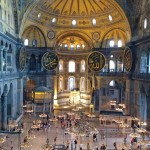The list of commandments in Leviticus 19 expands beyond the other versions of the Ten Commandments. This list makes it perfectly clear that God is a God of justice, right order. Loyalty to God demands that we structure our lives around these life-giving principles. We are not to steal, lie, swear falsely, or profane God’s name. We are to love our neighbor as ourselves (Note this is in the Old Testament); therefore, we do not rob or defraud our neighbor. We do not withhold the wages of day laborers. We are not to curse the deaf even though they never hear what we are saying. How cruel it would be to place stumbling blocks before the blind. We are to render just judgment and treat all people evenhandedly. Think of how peaceful the world would be if we stopped spreading slander. We are not to stand by idly when our neighbor is in dire peril. Finally, we are not to take revenge or cherish grudges. A tall moral order indeed; however, these are the rules that help us build our first half of life containers. Continue reading
Monthly Archives: February 2013
Be Countercultural
Seems like Christmas was just a few weeks ago. Now we are celebrating the first Sunday of Lent. Tempus fugit! Time flies. We have emerged from the Christmas season celebrating the incarnation of the Christ, sojourned through a few weeks of ordinary time and now are entering a time of reflection and penance. Rohr reminds us that Lent can be a liminal desert experience for us if we use the time to reexamine our lives as Christians. BTW, liminal means threshold. Lent puts us on the threshold of baptismal renewal at Easter. Continue reading
Follow Me and Share a Meal
My wife sometimes reminds me that Richard Rohr teaches that Jesus did not say, “Worship me.” Jesus said, “Follow me.” I imagine the results if Jesus had walked up to Levi’s tax collector’s booth and said, “Worship me.” Remember that Levi was an outlaw among his own people because he was part to the system that was ripping them off. He collected the taxes plus whatever value added he could impose for his own profiteering. If Jesus has said, “Levi, follow me,” Levi would probably still be in his tax booth happily ripping off his compatriots. Continue reading
Real Fasting
In frustration, we cry out to God. Come, save us, make our lives right. Restore order and harmony. Give us peace. What is wrong? We go to church every Sunday. We say our prayers. We listen to sermons. Some of us in Eucharistic churches share in Jesus’ body and blood. Yet, our lives are miserable. Wars, murderous rampages, draught, famine, high carbon fuel prices, contaminated food supplies, dirty water, shrinking IRAs, a burgeoning debt and a failing economy. C’mon, God, why? What is happening? Why aren’t you listening to our cries and pleas? We even fast during Lent? Yet, it is more of the same old stuff day after day. Vanities of vanities and all is vanity. Lamentation upon lamentation and yet to no avail! Continue reading
Choose LIfe-The Path of Descent
Richard Rohr popularizes Carl Jung’s two halves of life theory. The first half, the length of which varies from person to person, is about building the container. Early on we are on the path of ascent building our ego, building structures which will help us establish ourselves. It’s about us, our work, our dreams, our accomplishments, our families and our lives. At some point, we grow into a sense of futility about what we have been about. My experience is that the path of descent is not a single event, though it may be. Rather, it is about adjusting to the changes that life throws at us when the joints stiffen from arthritis and when the systems which served us well in the first half start to dwindle or even fail. When I was growing up, we were bombarded with aspirin ads during the nightly news. Now we are bombarded with ads about Androgel for Low T(estosterone) and Cialis to be ready for the right time! Continue reading
Ash Wednesday 2013
“Remember that you are dust and to dust you shall return.” This solemn pronouncement during the imposition of ashes signals the beginning of Lent. Lent is usually a somber time when our hang-dog fasting look gives away the fact that we are not really very good at fasting in secret.
But is it so somber? Think for just a minute. The call to metanoia, repentance, transformation is also a reminder, as our Buddhist friends say, of our face before we were born. We ARE dust—the stardust flaring forth from the Creator in whose very image and likeness we are created. We have a spark of the Divine within us.
Lent, therefore, presents us with a paradox—our mortality and our divine destiny. We live during Lent in the liminal space between death and resurrected life in the Cosmic Risen Christ. One foot stands on death and the other stands on life, which is the Paschal mystery.
In the January Experience conference, Old Testament scholar Walter Brueggemann reflected on Daniel’s prayer in chapter 9. God says, “I love you.” Daniel, representing all the people, responds, “We have sinned.” God responds, “I forgive you.” Like Daniel, Joel called the people to prayer, fasting and repentance. In both Daniel and Joel, the mind of God was changed by the efficacy of prayer, “Then the LORD was stirred to concern for his land and took pity on his people.”
Lent is a time to rediscover our face before we were born. It is the time to truly believe that God will intervene in our lives to make gift us with boundless shalom—health, well-being, wholeness. Prayer in the secret room of our hearts, almsgiving to alleviate human misery, and fasting to discipline what Francis called “Brother Ass” (and to promote health and well-being—shalom) all serve to lead us into the depths of our true self. Lenten practice helps us to fan the flames of the divine spark deep within us so that we might come to new life—life in Christ Jesus. Now is indeed the acceptable time to become what we are.
Lent is an invitation to enter more fully into the second half of life. The path of ascent in the first half of life has created the container which is ego-driven. Awakening to the challenges of the second half of life leads us on the path of descent—descent into our true self where the Divine dwells deep within us. As our Lenten practices lead us deeper and deeper into the dark depths of our true self, we answer the call to let go. We answer the call, as did Mary, to surrender to the Divine. We become one with the Jesus on the cross so that we might become the Christ of the resurrection.
Lent is about living in the Light—“I am the Light of the world.” The Creator’s first act on the first day of creation was to create light. Light is the ultimate metaphor for the Divine. Hildegard of Bingen and Thomas Merton both recognized the Light in the second half of their lives. Hildegard’s musical composition, Symphonia, and Merton’s poem, Hagia Sophia, both contain innumerable references to the Light. Hildegard scholar Barbara Newman entitled one book, Voice of the Living Light. Hildegard reports that she first saw “The Shade of the Living Light” when she was three. She began to write about her visions when she was 42 (second half path of descent). Merton shows a comprehensive understanding of the path of descent in his last years. One of the many references to Wisdom in his masterful poem, Hagia Sophia, is, “We do not hear mercy, or yielding love, or non-resistance, or non-reprisal. In her there are no reasons and no answers. Yet she [Wisdom] is the candor of God’s light, the expression of His simplicity.”
We are emerging from the darkest part of the year. The glimmer of Easter hope is lighting our way to renewed life in the Risen Cosmic Christ who is the Light of the world and the expression of God’s simplicity—mercy, love, compassion.
Shine on
Today’s scripture readings focus on Moses’ experience of the Divine on Sinai and Jesus’ experience of the Divine on Tabor. The light shining forth from Moses’ face was an indication of the divine glory. The change in Jesus’ face and his dazzling bright clothing also was a manifestation of the divine glory (shekinah, doxa). God’s glory is ultimately enshrined in the Ark of the Covenant and then the Temple as a sign of God’s presence. God’s glory was enshrined in both Moses and Jesus.
Creation is the primary revelation of God’s glory. As Merton said, “A tree gives glory to God by being a tree.” All creation glorifies the Creator as it flares forth from the original energy of the divine stardust.
We too are created in the image of God. God’s glory shines forth in us and through us. The eastern Church had a better grasp of this. God became incarnate, human so that we might become divine. God hovers over us as light and names us as God’s precious children. The Spirit is transforming us into divinity. We become more like God—loving, merciful, and compassionate.
In recent conferences, both Richard Rohr and Matthew Fox said that light is the primary metaphor for God. In the 12th century, the Benedictine nun, Hildegard of Bingen, now a saint and doctor of the church, understood this, “The compassion of the grace of God will make humans light up like the sun.” (Scivias, 84) Twelve centuries later, Benedictine Trappist monk, Thomas Merton also got it, ““There is no way of telling people that they are all walking around shining like the sun.” (Conjectures of a Guilty Bystander, 153)
We light up like the sun and we walk around shining like the sun. The Spirit is transforming us as Moses and Jesus were transformed on Sinai and Tabor. We are light. In fact, Jesus said we are the light of the world and reminded us that He is the way, the truth, and the LIGHT! We are light. We are stardust glowing and flaring forth from the Creator. God dwells within us even more powerfully than God ever dwelt in a temple. We are, as Paul says, temples of the Holy Spirit. We live the very Spirit of the Risen Cosmic Christ as we dwell in the community which is the Body of Christ. We are beloved sons and daughters with whom Abba God is well pleased.
Shine on!!! Glory on!!! Manifest the glory of God by being what you can become—being fully human as the tree is fully tree.







